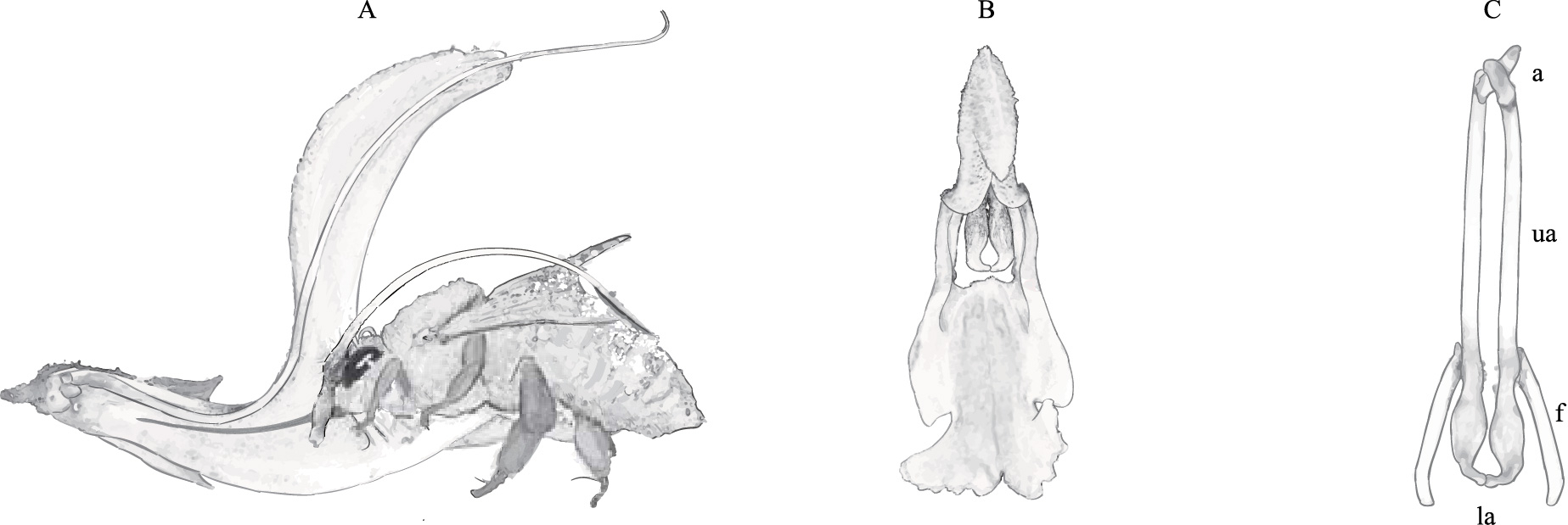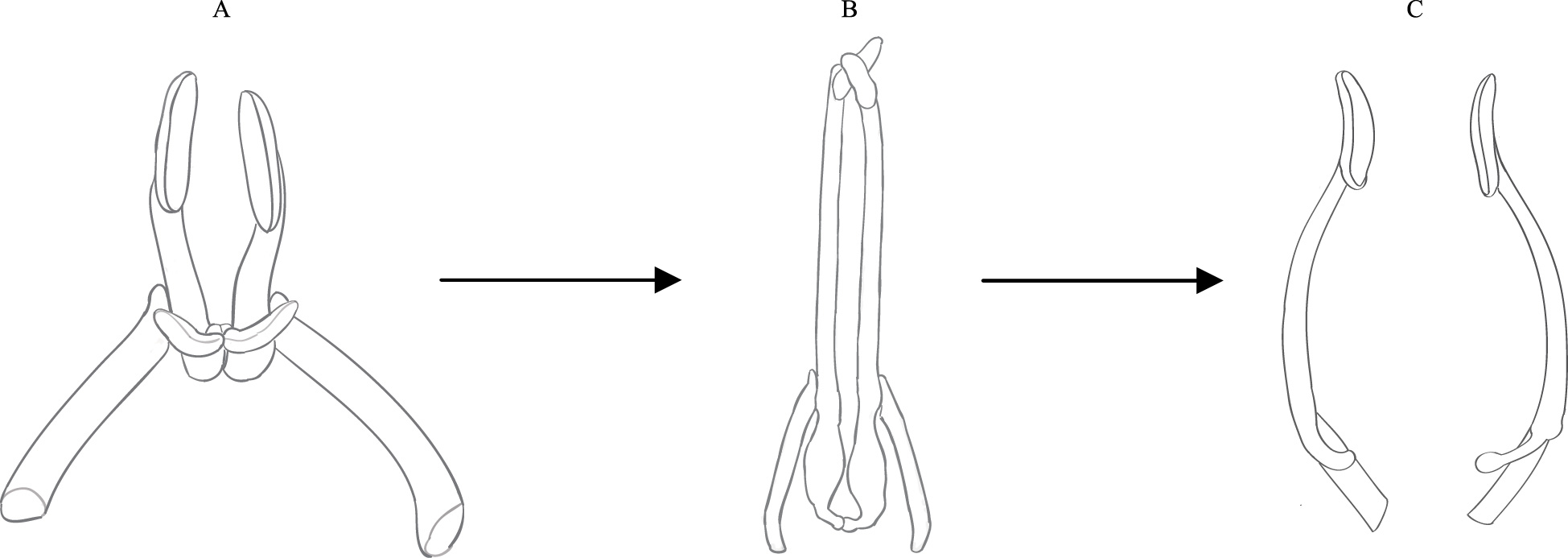文章信息
- 黄艳波, 魏宇昆, 葛斌杰, 王琦
- HUANG Yanbo, WEI Yukun, GE Binjie, WANG Qi
- 鼠尾草属东亚分支的传粉模式
- Pollination Mechanisms of genus Salvia (Lamiaceae) in East Asia (China)
- 生态学报, 2014, 34(9): 2282-2289
- Acta Ecologica Sinica, 2014, 34(9): 2282-2289
- http://dx.doi.org/10.5846/stxb201308152084
-
文章历史
- 收稿日期:2013-8-15
- 修订日期:2014-1-6
鼠尾草属(Salvia L.)植物以富含多种芳香成分而著称,其含有的多种活性次生代谢产物在药物、食品、化妆品领域均有广泛的应用。本属是唇形科最大属和进化分支顶级[1],约1000种左右,世界分布,具有雄蕊退化成2枚的特征,线形药隔并与花丝形成关节等花器官特征显示,鼠尾草的传粉结构为适应传粉生物而高度特化[2]。美洲、地中海和东亚是鼠尾草属的3个多样性中心[3],对叶绿体基因片段和雄蕊结构的分析初步证明,鼠尾草属的3个分布中心可能经历了平行进化(parallel evolution)过程。以往的研究只关注了美洲和地中海类群,而对东亚尤其是中国的鼠尾草属植物传粉生物学没有系统而完整地研究,对不同类群的雄蕊结构和传粉模式仍不清楚。本文基于对中国分布的鼠尾草属植物雄蕊结构和传粉过程的观察,结合植物的属下分布格局,在亚属水平上对其传粉模式的变化和可能的进化方向做了分析与讨论。雄蕊杠杆结构是否在东亚鼠尾草属物种辐射与多样性形成中具有关键作用,是值得进一步深入研究的问题,而对其雄蕊传粉结构功能的深入了解,对其适应性进化的阐明,将对该属植物雄蕊与传粉者在物种多样性形成和是否存在协同进化等研究提供有价值的参考。
1 鼠尾草属多样性的花器官与传粉模式对鼠尾草属花器官的描述显示其花冠的长度差异明显(4.5—130mm)、形态各异、颜色类型多样,雄蕊结构的细微变化可能改变植物的传粉模式,进而影响其繁育系统和物种多样性的形成,因此对花器官多样性形成及其功能研究尤为重要[1]。鼠尾草属有高度特化的二强雄蕊,两个发育雄蕊药隔明显伸长将花粉囊分开,花丝与药隔连接处形成“关节”,将药隔分为上下臂,在传粉生物触动杠杆下臂向内运动时,整个雄蕊以“关节”为轴,上臂向下运动,将花粉涂抹在传粉者的背部完成传粉,是为典型的雄蕊背部杠杆传粉模式。除此之外,根据花丝和雄蕊长度,花丝与药隔比例,雄蕊上下臂花药发育状况,上下臂联合程度,雄蕊是否伸出花冠筒等特征又演化出多种雄蕊结构,形成多样化的传粉模式[4, 5]。鼠尾草属的二强雄蕊降低了雌雄蕊功能干扰的可能[6],花粉输出效率更高[7]。
鼠尾草属植物传粉模式按照花粉接触部位分为背部、腹部、体侧、额和翅部传粉,除背部传粉属于典型的杠杆模式外,另外几种杠杆通常弱化或完全退化;按照雄蕊的运动方式可分为被动位移与主动运动[8],被动位移又可分为自上而下,自下而上和水平运动。鼠尾草属雄蕊主动运动只在少数类群中出现,某些类群的雄蕊随着花粉不断散播,伸长的药隔逐渐向下内卷,而后熟的雌蕊逐渐占据雄蕊花药原来的位置,接受传粉者带来的花粉。在某些情况下,雄蕊的运动直接决定了访花者与花药(粉)接触的频率和精确性,影响着雌蕊的繁殖成效[9]。
根据传粉生物,鼠尾草可分为虫媒和鸟媒两类传粉模式,虫媒以蜂类传粉为主,极少数为蝶、蝇或蛾类。对背部杠杆传粉模式的植物而言,雄蕊的结构保证了传粉的忠实性和可靠性。对于同域分布的几种鼠尾草,虽具有重叠的花期和传粉蜂,但可通过花冠的大小、杠杆的长度,控制花药触碰到蜂体的不同部位,通过机械隔离实现精确传粉,从而避免杂交[10];另外,还可通过杠杆下臂先端联合形成的三维结构,迫使昆虫需推动下臂才能进入花冠取食花蜜,增加杠杆运动的稳定性,固定访花时昆虫取食花蜜的姿态,进一步保证传粉的可靠性和精确性[11]。更为特化的例子如草地鼠尾草(S. pratensis)[11]和丹参(S. miltiorrhiza)的雄蕊结构与传粉者的适应性进化,雄蕊下臂增大联合形成匙状,中间留一小孔,蜂只能通过口器深入小孔,推动下臂取食冠筒基部花蜜,同时保证雄蕊更稳定而规则地运动,将花粉有效地传播出去。
鸟媒的鼠尾草主要传粉者是蜂鸟[12],根据传粉模式分为杠杆(92个种)和退化的杠杆结构两大类[13, 14]。一般认为鸟媒比蜂媒进化,鸟媒中的退化杠杆则比杠杆结构更进化[1]。鸟媒的杠杆传粉是通过喙部推动杠杆运动,花粉借助鸟类的头部或前额传播。在退化杠杆模式中,药隔下臂紧贴冠筒上壁,缺少活动空间,药隔与花丝连接处也未发育成可自由运动的“关节”,雄蕊的杠杆作用消失,当蜂鸟进入冠筒取食花蜜时,雄蕊花药直接触碰蜂鸟前额而完成传粉[13]。
对于鼠尾草属植物的多样性分布和起源中心有不同见解。吴征镒等[2]认为鼠尾草属是一个世界分布属,没有明显的分布中心,原始类群分布于地中海至中亚和墨西哥至美国南部,随后逐步扩散形成现在的分布格局[15];Claen-Bockhoff等人认为全世界有6个分布中心[16],而Walker等人认为世界鼠尾草属有3个多样性中心[3]。推测鼠尾草属起源于地中海和西亚[2, 16],也有可能起源于东亚[17]。最近根据分子系统学和形态学分析表明,鼠尾草属并非是以前认为的单系,而可能是在3个多样性中心经历了平行进化,3个进化分支分别与属外其他近缘类群构成独立的起源,雄蕊结构均从原始的杠杆结构演化为更进化的形式[18]。如美洲中心的蜂媒进化为鸟媒,由杠杆进化为非杠杆的传粉结构;地中海中心的原始杠杆结构进化为典型背部杠杆传粉结构等[18]。鼠尾草属的物种数量远多于唇形科其他属,它们的雄蕊杠杆结构与传粉生物的适应性进化可能触发了该属的适应辐射和多样性的产生[10],新物种时有发现[19, 20, 21, 22, 23, 24, 25]。雄蕊结构可能是鼠尾草属起源和演化的关键性状,雄蕊结构与传粉生物的相互适应可能是其多样性产生的主要驱动力。
1.1 东亚(中国)类群的传粉模式其特征 1.1.1 东亚(中国)类群的分布格局与物种多样性本研究发现,原产中国的弧隔鼠尾草亚属(subg. Salvia Benth.)、荔枝草亚属(subg. Sclarea Benth.)和鼠尾草亚属(subg. Allagospadonopsis Briq.)的分布区域有所不同。弧隔鼠尾草亚属(44种)除个别物种传播至华中、华北及华东部分地区之外,主要分布区在中国西南部的滇、川、藏地区,多样性中心为横断山区;荔枝草亚属(20种)分布区在云贵高原以东,南岭以北,燕山以南的华中至华东地区,多样性中心不明显,但以大别山—桐柏山—伏牛山和川东—湘鄂两个区域物种多样性较高;鼠尾草亚属(18种)以秦岭—淮河以南长江中下游的华东、华中及华南地区为主要分布区,以天目山—黄山—武夷山和南岭为多样性较高的区域。从3个亚属的分布核心区(图 1)可以看出,尽管3个亚属的分布区有部分重叠,但仍然呈现出从西南至华东逐步替代性的分布趋势;从物种多样性角度分析,西南物种多样性最高,华中地区的荔枝草亚属其次,华东分布的鼠尾草亚属物种多样性最低。

|
| 图1 中国鼠尾草属3个亚属的核心分布区示意图 Fig. 1 The distribution pattern of three subgenera of Salvia in China |
东亚鼠尾草属花器官形态、颜色、大小,尤其是二强雄蕊的结构均表现出很高的多样性。笔者对中国分布鼠尾草属植物花器官的形态观察和解剖测量结果表明,3个亚属代表性物种的雄蕊结构和传粉模式明显不同,主要表现在花冠大小、雄蕊发育状况、上下臂是否联合、药隔长度、药隔与花丝比例、药隔上下臂的比例等(表 1),也是决定鼠尾草属传粉结构和功能的主要因素。除此之外,还有一些特殊形态的花器官结构,如苣叶鼠尾草(S. sonchifolia)和南川鼠尾草(S. nanchuanensis)的花冠筒明显变细增长呈管状;美丽鼠尾草(S. meiliensis)和河南鼠尾草(S. honania)的雌雄蕊完全伸出花冠之外,两个花药朝向内侧;荔枝草(S. plebeia)与佛光草(S. substolonifera)花冠的长度仅有5mm,雌雄蕊基本内藏于冠筒内等。
|
性状
Characters | 短药隔杠杆传粉模式
Type Ⅰ (short-lever type) | 长药隔杠杆传粉模式
Type Ⅱ (long-lever type) | 退化杠杆传粉模式
Type Ⅲ (degraded-lever type) |
|
轮伞花序花数量
No. of verticillaster flower | 2—6 | 6或多花 | 2—多花 |
|
花冠形态
Corolla shape | 花冠大型(长10—50mm),上唇多平伸短于冠筒 | 花冠大型或小型(长(4.5)—40mm),大型花冠上唇长于冠筒,直立近90° | 花冠小型(长5—13mm) |
|
雄蕊形态
Stamen shape | 药隔弯成半圆形或弧形,花药内藏于上唇 | 药隔不为半圆形,上臂多少直伸,花药内藏于上唇 | 药隔不为半圆形,上臂多少直伸,花药多少外露 |
|
雄蕊发育状况
Stamen development status | 上下臂花药均发育,上臂分离,下臂先端靠合 | 上臂花药发育、分离,下臂不育,先端明显增大、联合 | 上臂花药发育、靠合或分离,下臂不育,退化瘦小分离 |
|
药隔与花丝比例
Proportion of connective and filament | 药隔比花丝短,或等长或稍长 | 药隔远长于花丝,常为2—10倍甚至更长 | 药隔远长于花丝,常为2—6倍 |
|
药隔上下臂比例
Upper and lower arm of connective | 上下臂等长或上臂稍长 | 上臂远长于下臂 | 上臂远长于下臂 |
|
传粉模式
Pollination mechanism | 以背部杠杆传粉模式为主,兼有其他模式 | 典型的雄蕊背部杠杆传粉模式 | 杠杆传粉模式弱化或退化 |
|
出现类群
Occurrence group | 弧隔鼠尾草亚属
(subg. Salvia Benth.) | 荔枝草亚属
(subg. Sclarea Benth.) | 鼠尾草亚属
(subg. Allagospadonopsis Briq.) |
根据花器官形态、内部结构、雄蕊特征、花粉接触传粉昆虫的部位,可将中国的鼠尾草划分为3种主要传粉模式。
Type Ⅰ:短药隔杠杆传粉模式(short-lever type),主要出现在弧隔鼠尾草亚属,药隔有一定伸长,但上下臂的花药均发育产生花粉。如圆苞鼠尾草(S. cyclostegia)具药隔增长的双药室雄蕊,药隔弧形,两端药室均发育,下臂花药顶端联合,传粉模式以背部杠杆传粉模式为主,兼有腹部等其他传粉模式(图 2)[26]。

|
| 图2 短药隔杠杆传粉模式与雄蕊结构 Fig. 2 The pollination mechanism and stamen structure of short-lever type A. 传粉情况Pollen transfer;B. 花冠筒正面观A front view through the flower tube showing lower arms of stamens;C. 雄蕊结构兼示雄蕊可育靠合下臂C. Stamen structure showing fertile upper and lower lever arms;Abbreviations: f,filament; a,anther; ua,upper arm; la,lower arm |
Type Ⅱ:长药隔杠杆传粉模式(long-lever type),主要发生在荔枝草亚属,药隔显著伸长,雄蕊下臂不育联合。以丹参(S. miltiorrhiza)为代表,具单药室(monothecate),下端药室退化不育,形成匙状增大,顶端联合,传粉模式为典型的背部杠杆传粉模式(图 3)。

|
| 图3 长药隔杠杆传粉模式与雄蕊结构 Fig. 3 The pollination mechanism and stamen structure of long-lever type A. 传粉情况Pollen transfer;B. 花冠筒正面观A front view through the flower tube showing lower arms of stamens;C. 雄蕊结构兼示雄蕊不育联合下臂Stamen structure showing fertile upper arms and fused sterile lower arms; Abbreviations: f,filament; a,anther; ua,upper arm; la,lower arm |
Type Ⅲ:退化杠杆传粉模式(degraded-lever type),主要发生在鼠尾草亚属,雄蕊下臂明显变小、萎缩,阻挡传粉者进入冠筒的杠杆作用弱化或退化。如铁线鼠尾草(S. adiantifolia),具单药室,下臂退化短小,不育且分离,据观察其传粉主要通过昆虫的头部进行,雄蕊结构的杠杆功能弱化,传粉模式为非杠杆的传粉模式(图 4)。基于雄蕊结构、发育状况及进化程度,可将Type Ⅰ(弧隔鼠尾草亚属)视为原始 的杠杆传粉模式,Type Ⅱ(荔枝草亚属)是较进化的背部杠杆传粉模式,Type Ⅲ(鼠尾草亚属)尽管部分失去杠杆传粉功能,但通过变窄的花筒开口、外露且相互靠合的花药,使得昆虫吻部刚进入即接触其头部进行传粉,比长杠杆(需昆虫头部进入花筒触动杠杆)更能适应访花时间短的小型昆虫,从节省能量消耗以及传粉稳定性、专一性考虑,可能是更为进化的传粉模式。

|
| 图4 退化杠杆传粉模式与雄蕊结构 Fig. 4 The pollination mechanism and stamen structure of degraded-lever type A. 传粉情况Pollen transfer;B. 花冠筒正面观A front view through the flower tube showing upper and lower arms of stamens;C. 雄蕊结构兼示雄蕊不育分离下臂Stamen structure showing fertile upper arms and separated sterile lower arms; Abbreviations: f,filament; a,anther; ua,upper arm; la,lower arm |
除了依靠昆虫传粉时的外力作用,雄蕊发生被动位移之外,还存在雄蕊的主动运动现象,雄蕊的主动运动主要出现在鼠尾草亚属和荔枝草亚属中具小型花的物种当中。它们的雄蕊先于雌蕊成熟,成熟具有花粉的雄蕊位于花冠筒的上部,蜂取食花蜜时通过其前额带走花粉,此时雌蕊尚未成熟而藏于花冠上唇,在雄蕊逐渐从成熟至衰老过程中,药隔上臂逐渐向下向内卷曲,此时雌蕊逐渐成熟并占据之前雄蕊花药的位置,以接受来自蜂携带的其他花的花粉,从而完成异花授粉。任明迅认为雄蕊的缓慢运动可以巧妙地调整不同花期的雄蕊处于不同的空间位置,可在不同阶段、不同位置分发花粉,这可能是提高花粉输出与传粉准确率的一种适应机制,促进了花的雄性功能;同时,雄蕊缓慢运动还可能提高调节雌雄蕊异位程度,影响着花内雌雄蕊功能干扰、自交与异交水平等[8, 9]。
二强雄蕊的合生或离生在雄蕊结构中也有不同的进化适应意义和传粉功能差异[27]。鼠尾草属的3个亚属雄蕊上下臂具有不同的发育及联合状况(表 1)。如弧隔鼠尾草亚属可育上臂离生,可育下臂花药靠合(其中苣叶鼠尾草上下臂的可育花药均靠合);荔枝草亚属的可育上臂离生,下臂不育花药合生;鼠尾草亚属的上臂可育花药靠合,下臂不育花药显著退化离生。雄蕊花药的合生状况是鼠尾草传粉功能的结构基础之一。Ren与Tang认为,雄蕊合生的好处在于通过聚集花药于同一位置,可以有效地将花粉传播出去,增加传粉者接触花粉的可能性和精确性,延长接触花粉的时间[27]。对于下臂不育联合的荔枝草亚属而言,可能也有相同的进化选择优势。在鼠尾草亚属中,大多数物种具有雄蕊上臂花药合生的现象,传粉蜂无须进入花冠筒,其前额便可稳定快速地触碰到花粉,由于雄蕊形态和结构较为稳定,雄蕊合生的不同方式以及合生程度可能也是重要的植物分类依据之一[28]。
1.2 传粉模式的进化与扩散基于杠杆状雄蕊的结构进化和系统发育过程,推测3种雄蕊结构和传粉模式的进化方向可能是从短药隔杠杆向长药隔杠杆至退化的杠杆模式进行(图 5),而3种传粉模式的分布格局可为其进化方向提供证据,也反映出雄蕊的进化历史和传粉模式的扩散方向(图 1)。短药隔杠杆传粉模式(Type Ⅰ)的雄蕊结构为原始模式,花丝较长,药隔伸长不明显,上下臂均可育,集中出现在中国西南横断山区,该地区也是弧隔鼠尾草亚属的多样性分布中心,仅有黄鼠狼花(S. tricuspis)向北扩散至山西和陕西中 部,荫生鼠尾草(S. umbratica)向东扩散至河北、安徽等省。从西南过渡到华中,传粉模式逐渐被长药隔杠杆传粉模式(Type Ⅱ)所替代,花丝明显变短,药隔尤其是上臂显著伸长,下臂不育联合,具有此传粉模式的物种大多出现在大别山-桐柏山-伏牛山和川东-湘鄂两个区域。至华东和华南地区,传粉模式又逐渐被退化杠杆传粉模式(Type Ⅲ)所替代,花冠明显变小,药隔下臂退化、缩小,下臂分离,杠杆传粉功能弱化甚至完全丧失,这种传粉模式以秦岭-淮河以南长江中下游的华东、华中及华南地区为主要分布区,物种多样性中心在天目山-黄山-武夷山和南岭地区。西南横断山区有可能是鼠尾草属东亚分支的起源中心,该区域鼠尾草的雄蕊结构保留了更多的原始特征,其中少数物种延伸分布至中国的中东部,而原始的短药隔杠杆传粉模式从西南横断山区向北、东、南3个方向,进化扩散形成长药隔杠杆传粉模式和退化的杠杆传粉模式。

|
| 图5 中国分布鼠尾草属植物雄蕊结构可能的进化途径 Fig. 5 Hypothetical evolutionary trend of stamens in genus Salvia from China A. 短药隔杠杆传粉模式 Short-lever type;B. 长药隔杠杆传粉模式Long-lever type;C. 退化的杠杆传粉模式Degraded-lever type |
最近的研究认为鼠尾草属并非单系而是至少有3次独立的起源,分别在美洲、地中海至中亚和东亚,中国可能是东亚分支的起源中心[3, 19]。面对如此庞大而多样化的类群,目前的研究仅限于对少数传粉现象的描述,对东亚分支的鼠尾草属花器官多样性、传粉结构和传粉生物的适应性研究几乎没有涉及,急需开展大量的野外调查、形态解剖、传粉观察和定量分析等工作;对于东亚分支的雄蕊进化途径仍然未知,还需分子和形态两方面证据加以阐明。花内雄蕊的分化、运动以及进化适应在鼠尾草属物种形成中的研究价值显然比其他器官更为重要。雄蕊分化式样对传粉生态学、植物繁殖格局以及物种多样性形成的影响应该受到更多重视,也是传粉生物学的研究热点之一[29];雄性功能的资源分配和雄性适合度的实现是塑造花部特征的重要因素,因此需要更加重视两性花的雄性功能及其在花部特征塑造与花进化上的贡献[30]。鼠尾草属植物雄蕊的多样性无疑是较为理想的研究材料,未来还需要在完善鼠尾草物种多样性调查的基础上,深入系统地研究该区域鼠尾草属植物雄蕊结构及其与传粉生物的关系,结合对美洲和地中海两个分布中心鼠尾草属传粉模式的比较分析,期望阐明多样性传粉模式的进化方式及其所反映的物种多样性起源和方向。在已知的中国84种鼠尾草属植物中[31],仅对分布西南的圆苞鼠尾草(S. cyclostegia)传粉模式做过较深入的研究[32],对其他物种的传粉模式尚不清楚。中国的鼠尾草属植物物种丰富,花器官形态和雄蕊传粉模式多样,加之气候及地质环境复杂,特有物种或极小种群的存在可能性相对较大。本文仅从宏观层面对中国分布鼠尾草属的雄蕊结构和传粉模式做了概况性分析和总结,今后将结合物种分布格局和传粉模式,从宏观和微观两个层面对其传粉生物学以及与传粉生物的适应进化进行系统与量化研究,以揭示雄蕊杠杆结构在东亚鼠尾草属物种辐射与多样性形成中的作用。
致谢: 中国科学院武汉植物园任明迅博士对本研究给予帮助,刘欣雨女士帮助绘图,特此致谢。
| [1] | Wester P, Claßen-Bockhoff R. Pollination syndromes of New World Salvia species with special reference to bird pollination. Annals of the Missouri Botanical Garden, 2011, 98(1): 101-155. |
| [2] | Wu Z Y, Li X W. On the evolution and distribution in Labiatae. Acta Botanica Yunnanica, 1982, 4(2): 97-118. |
| [3] | Walker J B, Sytsma K J, Treutlein J, Wink M. Salvia (Lamiaceae) is not monophyletic: implications for the systematics, radiation, and ecological specializations of Salvia and tribe Mentheae. American Journal of Botany, 2004, 91(7): 1115-1125. |
| [4] | Zhang B, Sun S, Zhang Z Q, Li Q J. A review of the evolutionary and ecological significance of lever-like stamens. Chinese Journal of Plant Ecology, 2010, 34(1): 89-99. |
| [5] | Claßen-Bockhoff R, Crone M, Baikovay E. Stamen development in Salvia L.: homology reinvestigated. International Journal of Plant Sciences, 2004, 165(4): 475-498. |
| [6] | Ren M X. Intrafloral stamen differentiations and their adaptive significances. Chinese Journal of Plant Ecology, 2009, 33 (1) : 222-236. |
| [7] | Kudo G. Anther arrangement influences pollen deposition and removal in ermaphrodite flowers. Functional Ecology, 2003, 17: 349-355. |
| [8] | Ren M X. Stamen movements in hermaphroditic flowers: diversity and adaptive significance. Chinese Journal of Plant Ecology, 2010, 34 (7): 867-875. |
| [9] | Ren M X, Tang J Y. Up and down: stamen movements in Ruta graveolens (Rutaceae) enhance both outcrossing and delayed selfing. Annals of Botany, 2012, 110(5): 1017-1025. |
| [10] | Claßen-Bockhoff R, Speck T, Tweraser E, Wester P, Thimm S, Reith M. The staminal lever mechanism in Salvia L.(Lamiaceae): a key innovation for adaptive radiation? Organism, Diversity & Evolution, 2004, 4: 189-205. |
| [11] | Reith M, Baumann G, Claßen-Bockhoff R. Speck T. New insights into the functional morphology of the lever mechanism of Salvia pratensis (Lamiaceae). Annals of Botany, 2007, 100: 393-400. |
| [12] | Wester P, Claßen-Bockhoff R. Bird pollination in South African Salvia species. Flora, 2006, 201: 396-406. |
| [13] | Wester P, Claßen-Bockhoff R. Hummingbird pollination in Salvia haenkei (Lamiaceae) lacking the typical lever mechanism. Plant Systematics and Evolution, 2006, 257: 133-146. |
| [14] | Wester P, Claßen-Bockhoff R. Floral diversity and pollen transfer mechanisms in bird-pollinated Salvia species. Annals of Botany, 2007, 100: 401-421. |
| [15] | Wu Z Y, Sun H, Zhou Z K, Li D Z, Peng H. Floristics of seed plants from China. Beijing: Science Press, 2011: 120-121. |
| [16] | Claßen-Bockhoff R, Wester P, Tweraser E. The staminal lever mechanism in Salvia L.(Lamiaceae) a review. Plant Biology, 2003, 5, 33-41. |
| [17] | Dieringer G. Ramamoorthy T P. Tenorio Lezama P. Floral visitors and their behavior to sympatric Salvia species (Lamiaceae) in Mexico. Acta Botanica Mexicana, 1991, 13: 75-83. |
| [18] | Walker J B, Sytsma K J. Staminal evolution in the genus Salvia (Lamiaceae): molecular phylogenetic evidence for multiple origins of the staminal lever. Annals of Botany, 2007, 100: 375-391. |
| [19] | Donmez A. A new Turkish species of Salvia L.(Lamiaceae). Botanical Journal of the Linnean Society, 2001, 137: 413-416. |
| [20] | Celep F, Kahraman A, Dogan M. A new taxon of the genus Salvia (Lamiaceae) from Turkey. Plant Ecology and Evolution, 2011, 144(1): 111-114. |
| [21] | Huang X L, Li X W. Notes on Salvia Linn. in China. Acta Phytotaxonomica Sinica, 1981, 19(2): 245-249. |
| [22] | Li X W. New plants from Hubei, China. Bulletin of Botanical Research, 1983, 3(3): 67-73. |
| [23] | Su S W, Shen Z A, He J Q. New species of the genus Salvia from Anhui. Acta Botanica Yunnanica, 1984, 6(1): 55-62. |
| [24] | He J Q. A new species of the genus Salvia from China. Acta Botanica Yunnanica, 1989, 11(4): 409-411. |
| [25] | Zhu Z Y, Min B Q, Wang Q L. Taxa nova Salviorum labiatarum. Bulletin of Botanical Research, 2011, 31(1):1-3. |
| [26] | Zhang B, Sun S, Fang E Q, Bai X M. Evolutionary response of staminal lever mechanism of different species in Salvia to spatial variation in pollinators. Chinese Journal of Plant Ecology, 2012, 36(7): 681-689. |
| [27] | Ren M X, Tang J Y. Anther fusion enhances pollen removal in Campsis grandiflora, a hermaphroditic flower with didynamous stamens. International Journal of Plant Science, 2010, 71(3): 275-282. |
| [28] | Ren M X. Stamen fusion in plants: diversity, adaptive significance, and taxonomic implications. Journal of Systematics and Evolution, 2008, 46 (4): 452-466. |
| [29] | Huang S Q. Guo Y H. Progress in pollination biology. Chinese Science Bulletin, 2000, 45(3): 225-237. |
| [30] | Ren M X, Jiang X H, Zhang D Y. Some important questions in plant reproductive ecology. Biodiversity Science, 2012, 20(3): 241-249. |
| [31] | Li X W, Hedge I C. Lamiaceae//Wu Z Y, Raven P H, eds. Flora of China. Beijing: Science Press and St. Louis: Missouri Botanical Garden Press, 1994, 17: 196-223. |
| [32] | Zhang B, Claßen-Bockhoff R, Zhang Z Q, Sun S, Luo Y J, Li Q J. Functional implications of the staminal lever mechanism in Salvia cyclostegia (Lamiaceae). Annals of Botany, 2011, 107: 621-628. |
| [2] | 吴征镒, 李锡文. 论唇形科的进化与分布. 云南植物研究, 1982, 4(2): 97-118. |
| [4] | 张勃, 孙杉, 张志强, 李庆军.杠杆状雄蕊及其进化生态学意义. 植物生态学报, 2010, 34(1): 89-99. |
| [6] | 任明迅. 花内雄蕊分化及其适应意义. 植物生态学报, 2009, 33 (1) : 222-236. |
| [8] | 任明迅.两性花的雄蕊运动: 多样性和适应意义. 植物生态学报, 2010, 34 (7): 867-875. |
| [15] | 吴征镒, 孙航, 周浙昆, 李德洙, 彭华.中国种子植物区系地理.北京: 科学出版社, 2011: 120-121. |
| [21] | 黄秀兰, 李锡文.鼠尾草属一些种类的增订. 植物分类学报, 1981, 19(2): 245-249. |
| [22] | 李锡文.中国湖北产新植物. 植物研究, 1983, 3(3): 67-73. |
| [23] | 苏宋旺, 沈祖安, 何家庆. 安徽鼠尾草属新种. 云南植物研究, 1984, 6(1): 55-62. |
| [24] | 何家庆.中国鼠尾草属一新种.云南植物研究, 1989, 11(4): 409-411. |
| [25] | 祝正银, 闵伯清, 王秋玲.唇形科鼠尾属新植物. 植物研究, 2011, 31(1):1-3. |
| [26] | 张勃, 孙杉, 方强恩, 白小明. 鼠尾草属不同物种的雄蕊杠杆机制对传粉者空间变异的进化响应. 植物生态学报, 2012, 36(7): 681-689. |
| [28] | 任明迅. 植物雄蕊合生的多样性、适应意义及分类学意义初探. 植物分类学报, 2008, 46 (4): 452-466. |
| [29] | 黄双全, 郭友好. 传粉生物学的研究进展. 科学通报, 2000, 45(3): 225-237. |
| [30] | 任明迅, 姜新华, 张大勇. 植物繁殖生态学的若干重要问题. 生物多样性, 2012, 20(3): 241-249. |
 2014, Vol. 34
2014, Vol. 34




